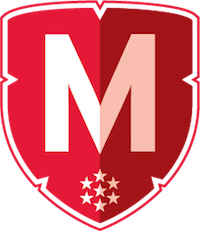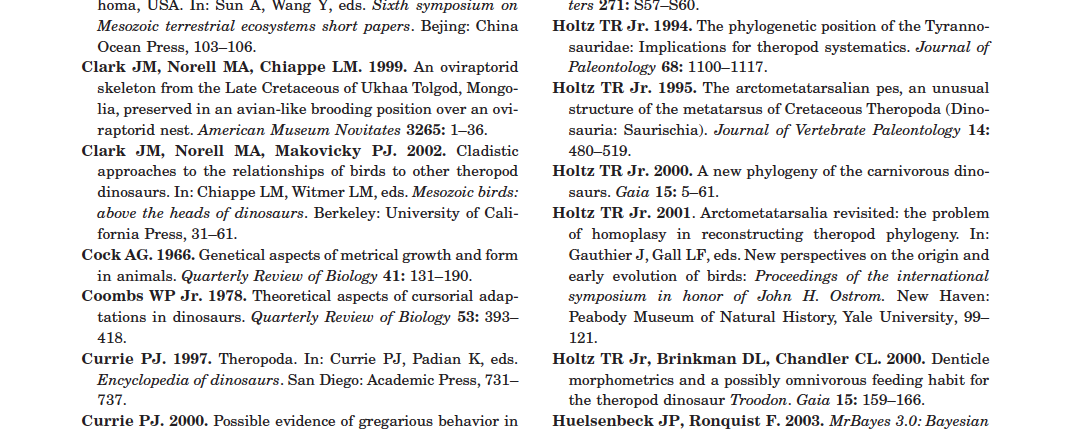


Bibliographic Style
While the secondary literature (Wikipedia; popular articles; etc.) are a useful way to start researching a topic, you need to get to the primary peer-reviewed literature in order to properly support your argument. This is the next best thing to actually measuring specimens and running analyses yourself.
Different journals and different courses might require different particular styles of bibliographical reference. The following examples show the preferred style for this course: it represents a common style that many print journals and technical books use.
[NOTE: Even though you are probably going to find the online versions of these papers rather than the physical hardcopy printed version, the convention is to use the printed version as the proper citation format. The important exception to this is that you should include the doi where it is available. The doi is the Digital Object Identifier. These are a string of characters that specify this particular article for various websearch methods. Papers published since 2000 typically have a doi; you should be citing these along with the rest of the bibliographic information. You can use this code in a specialized search engine like http://www.doi.org, or by tacking "http://dx.doi.org/" in front of the code, and use this as a URL in a standard web browser.]
Single Author Paper in Technical Journal
Format:
Author family name, Initial of first (and middle) names. Date of publication. Title of paper. Journal Title [in italics] Volume Number [emboldened]: first page of article-last page of article. doi: [doi of paper]
Examples:
Brazeau, M.D. 2012. A revision of the anatomy of the Early Devonian jawed vertebrate Ptomacanthus anglicus Miles. Palaeontology 55: 355-367. doi: 10.1111/j.1475-4983.2012.01130.x
Buttefield, N.J. 2011. Animals and the invention of the Phanerozic Earth system. Trends in Ecology and Evolution 28: 81-87. doi:10.1016/j.tree.2010.11.012
Multi-author paper in Technical Journal
Format:
First author family name, Initial of first (and middle) names of first authors, Intial of first (and middle) names of second author Second author family name, [and continued until], and Initial of first (and middle) names of last author Last author family name. Date. Title of paper. Journal Title Volume Number: first page-last page. doi: [doi of paper]
Examples:
Fricke, H.C., J. Hencecroth, and M.E. Hoerner. 2011. Lowland-upland migration of sauropod dinosaurs during the Late Jurassic Epoch. Nature 480: 513-525. doi: 10.1038/nature10570
Ksepka, D.T., and J.A. Clarke. 2012. A new stem parrot from the Green River Formation and the complex evolution of the grasping foot of Pan-Psittaciformes. Journal of Vertebrate Paleontology 32: 395-406. doi: 10.1080/02724634.2012.641704
Early View/In Press/Online in Advance of Print Paper
Many publications with an online presence will publish a few of their papers on line weeks or months before the printed verison is available. These are sometimes called "Early View" or "Online in Advance of Print" or similar titles. You should feel free to cite these in your wikis. Please use the following format for these (basically just a variation on the final printed versions above):
Examples:
Butler, R.J., O.W.M. Rauhut, M.R. Stocker, and R. Bronowicz. in press. Redescription of the phytosaurs Paleorhinus ('Francosuchus') angustifrons and Ebrachosuchus neukami from Germany, with implications for Late Triassic biochronology. Zoological Journal of the Linnean Society in press.
doi: 10.1111/zoj.12094
Online-Only Publication
There are a few journals which are online-only. In the paleontology field, one of the oldest is Palaeontologia Electronica. The most successful, however, are the various subdivisions of the Public Library of Science (PLoS), especially PLoS ONE and PLoS Biology. Another important source is PeerJ (which also provides pre-peer reviewed manuscripts: basically, works in progress.) Different online-only journals are developing their own version of "volume" and "pages", given the fact they aren't published as actual print items. Below are cases from PLoS ONE
and Palaeontologica Electronica.
Examples:
Butler, R.J., P.M. Barrett, and D.J. Gower. 2012. Reassessment of the evidence of the postcranial skeletal pneumaticity in Triassic Archosaurs, and the early evolution of the avian respiratory system. PLoS ONE 7(3): e34094. doi: 10.1371/journal.pone.0034094
Vitek, N.S. 2012. Giant fossil soft-shelled turtles of North America. Palaeontologica Electronica 15 13A, 43p; palaeo-electronica.org/content/2012-issue-1-articles/210-giant-soft-shelled-turtles
Memoir or other Monograph
Format:
Authors [as per papers]. Date. Title of monograph. Name of Series. Volume Number: X-XX.
Examples:
Donovan, S.K., R.E. Widdison, D.N. Lewis, and F.E. Fearnhead. 2010. The British Silurian Crinoidea: Part 2, Addendum to Part 1 and Cladida. Monograph of the Palaeontographical Society 635: 47-133.
Rinehart, L.F., S.G. Lucas, A.B. Heckert, J.A. Spielmann, and M.D. Celesky. 2009. The paleobiology of Coelophysis bauri (Cope) from the Upper Triassic (Apachean) Whitikaer quarry, New Mexico, with detailed analysis of a single quarry block. New Mexico Museum of Natural History & Science 45: 1-260.
Chapter in Edited Volume
Note: these rarely have doi numbers.
Format:
First author family name, Initial of first (and middle) names of first authors, Intial of first (and middle) names of second author Second author family name, [and continued until], and Initial of first (and middle) names of last author Last author family name. Date. Title of chapter. Pp. first page-last page, in Initial of first (and middle) names of first editor Last name of first editor, Initial of first (and middle) names of second editor Second editor family name, [and continued until], and Initial of first (and middle) names of last editor Last editor family name (eds.), Book Title [additionally, if part of a series: Name of Series Volume Number] Publisher; City of Publication.
Examples:
Holtz, T.R., Jr. 2008. A critical reappraisal of the obligate scavenging hypothesis for Tyrannosaurus rex†and other tyrant dinosaurs. Pp. 370-396, in P. Larson and K. Carpenter (eds.), Tyrannosaurus rex: The Tyrant King. Indiana University Press; Bloomington, IN.
Ostrom, J.H. 1980. The evidence for endothermy in dinosaurs. Pp. 15-54, in R.D.K. Thomas and E.C. Olson (eds.), A Cold Look at the Warm-Blooded Dinosaurs. AAAS Selected Symposium 28. Westview Press; Boulder, CO.
Book
Format:
Authors [as per papers]. Date. Title of Book. [additionally, if part of a series: Name of Series Volume Number] Publisher; City of Publication. Total number of pages pp.
Examples:
Carroll, R.L. 1997. Patterns and Processes of Vertebrate Evolution. Cambridge Paleobiology Series 2. Cambridge University Press; Cambridge, UK. 448 pp.
Vogel. S. 1988. Life's Devices: The Physical World of Animals and Plants. Princeton University Press; Princeton, N.J. 367 pp.
